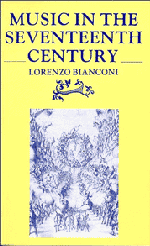I - THE EARLY DECADES
Published online by Cambridge University Press: 01 June 2011
Summary
The seventeenth-century madrigal
To modern eyes, a survey of the musical life of Italy during the first two decades of the Seicento reveals a number of innovations, ‘inventions’ destined (as a knowledge of later seventeenth-century musical history will show) to fall on fertile ground. There is the rise of the basso continuo; the vocal solo with instrumental accompaniment; the birth of opera. As examination of the music of the preceding century will show, these three ‘inventions’ are in reality the natural outcome of underground practices and experiments that run through much of the earlier period. If they appear so distinctly around the years 1600–02 (not only, indeed, to the eyes of the modern observer, but also to those of contemporaries), this is to be attributed to the fact that only now had their excellence and effectiveness begun to be brought to the attention of a more general public by musical printing. One need think only of the Cento concent ecclesiastici … con il basso continuo per sonar nell'organo (1602) of Ludovico da Viadana, the Nuove musiche (1602) for vocal solo by Giulio Caccini, the two different settings of Musiche … sopra l'Euridice del sig. Ottavio Rinuccini (both published in the winter of 1600–01) respectively by Jacopo Peri and Giulio Caccini, and the Rappresentazione di Anima et di Corpo (1600) of Emilio de' Cavalieri.
- Type
- Chapter
- Information
- Music in the Seventeenth Century , pp. 1 - 44Publisher: Cambridge University PressPrint publication year: 1987

